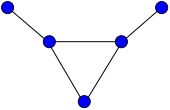|
Bull graph
In the mathematical field of graph theory, the bull graph is a planar undirected graph with 5 vertices and 5 edges, in the form of a triangle with two disjoint pendant edges.[1] It has chromatic number 3, chromatic index 3, radius 2, diameter 3 and girth 3. It is also a self-complementary graph, a block graph, a split graph, an interval graph, a claw-free graph, a 1-vertex-connected graph and a 1-edge-connected graph. Bull-free graphsA graph is bull-free if it has no bull as an induced subgraph. The triangle-free graphs are bull-free graphs, since every bull contains a triangle. The strong perfect graph theorem was proven for bull-free graphs long before its proof for general graphs,[2] and a polynomial time recognition algorithm for Bull-free perfect graphs is known.[3] Maria Chudnovsky and Shmuel Safra have studied bull-free graphs more generally, showing that any such graph must have either a large clique or a large independent set (that is, the Erdős–Hajnal conjecture holds for the bull graph),[4] and developing a general structure theory for these graphs.[5][6][7] Chromatic and characteristic polynomial The chromatic polynomial of the bull graph is . Two other graphs are chromatically equivalent to the bull graph. Its characteristic polynomial is . Its Tutte polynomial is . References
|
||||||||||||||||||||||||
Portal di Ensiklopedia Dunia



